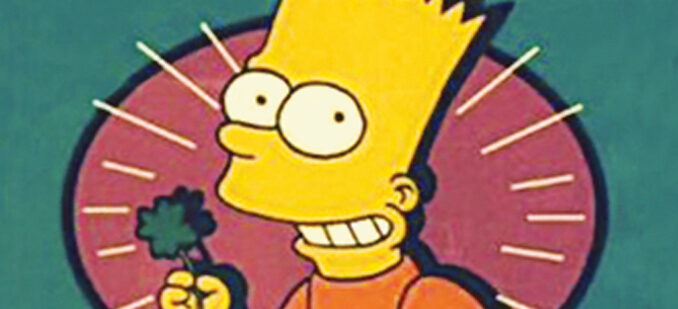
Aye, Carumba! Groening art wasn’t the first Sketch Card
By Mark Voger, author
‘The Dark Age: Grim, Great & Gimmicky Post-Modern Comics’
If you Google “Who drew the first Sketch Card” — as I have once in a while over the years — “The Simpsons” creator Matt Groening is nearly always the name at the top, for his Art De Bart cards of 1993.
 The Internet is wrong (and not for the first time).
The Internet is wrong (and not for the first time).
I’m not tooting my own horn so much as setting the record straight. My trading card series of 1993, Defective Comics Trading Cards, introduced the Sketch Card. (It’s right there on the wrapper; I named the format as well.) For decades, I couldn’t be certain of this, but new information has come to light over the past few years.
In 2020, I was contacted by a Sketch Card expert and collector (he wishes to remain anonymous) who is particularly interested in the birth of the format. This person wanted to know if I conceived of and named the Sketch Card (I did), or if I was following a directive from Defective’s publisher, Active Marketing International (I wasn’t). I explained that Active asked me to come up with an idea for a “gimmick” they could use to hype Defective, and I then conceived and pitched the Sketch Card concept.

Which came first?
Neither of us — myself or this expert — were certain which 1993 set was released first, Defective Comics Trading Cards or SkyBox’s The Simpsons Trading Cards Series 1 (which promised 400 Art De Bart cards as random premiums). What would have been helpful in settling this question are 1993 editions of Previews, Diamond’s monthly catalog of upcoming product in the comic-book world. These are hard to find today. But even if obtained, Previews would not be 100 percent reliable, since back then, delays were common in the comics biz. (Ask any 1990s comic shop proprietor.)
So this expert used another tack. Defective, The Simpsons and a third set from 1993 with Sketch Cards (according to him), Dark Dominion Zero Issue, all came with sweepstakes cards redeemable for spiffy prizes. (The ’90s was the golden age of gimmicks.) And these sweepstakes had deadlines.
Quoth the expert (via email): “Three sets came out in 1993 with Sketch Cards. I found a cool, indirect way to deduce the order. Your set had a sweepstakes that expired Jan. 31, 1994. The Simpsons redemption card expired June 30, 1994. And the final set with Sketch Cards, Dark Dominion Zero Issue, had a redemption card that expired Dec. 31, 1994. The months literally couldn’t be further apart, so it’s nice and clean-cut.”
This was encouraging news (to me), but not quite a lock. Until …
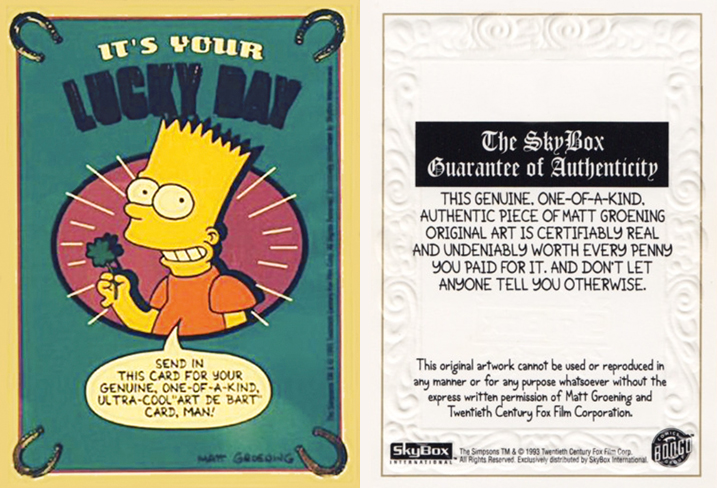
Redemption cards
Another significant development put Defective ahead: Groening did not illustrate the Art De Bart cards until long after the release of SkyBox’s The Simpsons Trading Cards Series 1.
The Art De Bart cards, you see, were not pack-inserted. Instead, so-called “redemption” cards were inserted. Lucky recipients of redemption cards had to mail them back, in order to — you guessed it — “redeem” an Art De Bart card. Groening would then draw on the gold-embossed cards, which would be mailed back to the consumers. From the fine print: “Autographed cards will be mailed beginning approximately Feb. 15, 1994. Please allow six to eight weeks for delivery.”
Feb. 15, 1994? Six to eight weeks? The phrase “irrefutable evidence” comes to mind.
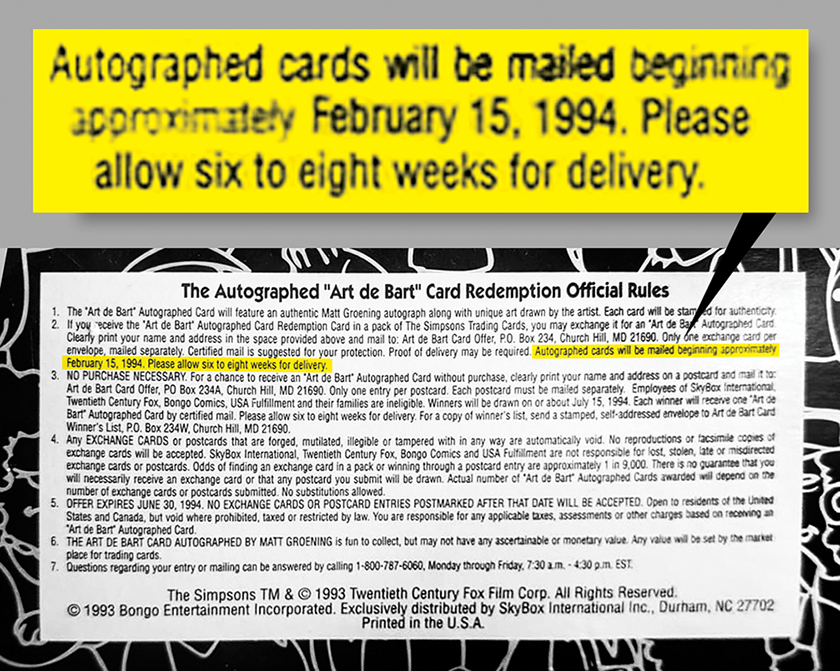
In the case of Defective, the consumer received the Sketch Card the moment she or he opened the pack. That’s what “pack-inserted” means. (And honestly, who would bother to mail in a redemption card for a nobody artist like me? It’s not worth the stamp.)
I did it like this: Prior to Defective’s release, I illustrated 500 original Sketch Cards, which I shipped to Active Marketing for pack-insertion. (Disclosure: Only two Defective Sketch Cards have turned up in online auctions. It’s probable that many more were retained by collectors or remain in unopened packs. But the expert suspects that not all of the 500 cards were pack-inserted. Which would be a shame, ‘coz it took me a couple of weeks to draw ’em.)
Recently, I gleaned a few more revelations about the Art De Bart cards from two online auctions — though I can’t imagine the auctioneers would be happy that there’s a credible challenger to the Creator of the Sketch Card throne.
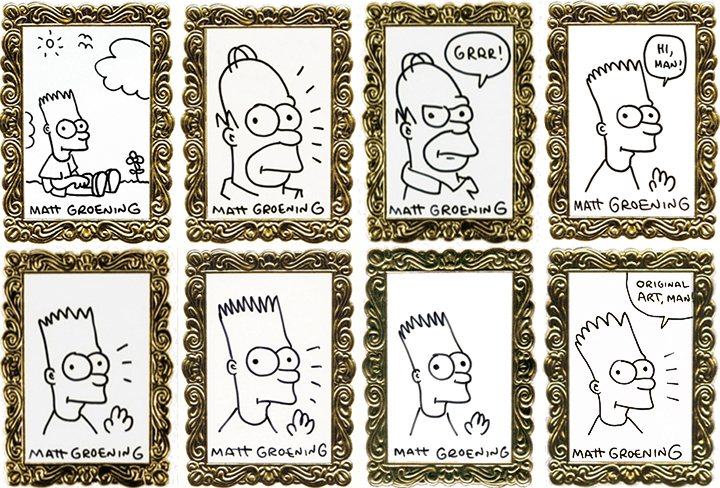
‘A simple sketch’
A PicClick auction described one of Groening’s Art De Bart cards as “a simple sketch of an iconic character in pop culture penned by his creator,” though the item description briefly contradicted itself.
First, it acknowledged that the card was “only available via redemption,” but then referred to it as “the hobby’s first pack-inserted Sketch Card.” (Huh? Which is it? It can’t be both.) Finally, the seller reiterates the redemption card protocol in clear language: “The only way to originally receive a card was to find a redemption card in a SkyBox pack of The Simpsons Trading Cards (1993 series), and then mail off for the Art De Bart card.”
The other auction, on a ComicArtFans gallery, provided some illuminating information about the redemption process. For instance, Groening apparently didn’t draw all 400 Art De Bart cards after all. Rather, he drew the cards “as needed” — only when the redemption cards were mailed in by consumers. Which they all weren’t.
“Matt Groening supposedly produced 400 Sketch Cards for SkyBox waaaaay back in 1993, years before SkyBox and Fleer changed the face of Non-Sports Cards with their ‘Sketchagraphs’ in 1997 and 1998. So this card is the Great-Granddaddy of the modern Sketch Card,” wrote this seller, who had on offer an Art De Bart card as well as a redemption card (called a “Lucky Day” card by SkyBox).
“A few of Groening’s cards were of other Simpsons characters, but he ran out of steam partway through and mass-produced Bart cards for the rest of his contribution. Only 400 ‘Lucky Day’ redemption cards were put into packs. Obviously, not all redemption cards were returned, so there are fewer than 400 art cards in circulation, and fewer than 400 redemption cards in circulation. Here, we have an extraordinarily rare pairing of one example of each. I have owned both for nearly 20 years, untouched in a safe deposit box since then.”
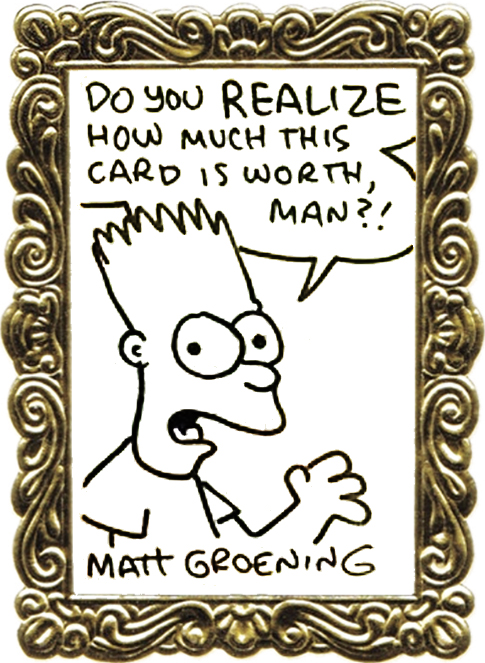
The bottom line
The asking prices for these cards were eye-popping. I haven’t checked back on either auction, but the PicClick one offered a “Buy It Now” price of $5,799.95 (with a “Make an Offer” option) for one of Groening’s Art De Bart cards.
Meanwhile, the ComicArtFans guy wrote: “One Art De Bart card sold on eBay in December of 2021 for the shocking price of $10,000. I would consider a sale price of $20K for this pair. They have already gone back (to the safe deposit box), so I am in no hurry. Serious offers only to make me drag them back out again.”
I wonder: Are these asking prices based on the fact that it’s Matt Groening himself, creator of “The Simpsons,” drawing the Art De Bart cards? (Plus, the cards are 29 years old?) Or are they based on the claim that the cards are “the hobby’s first pack-inserted Sketch Card” and/or the “Great-Granddaddy of the modern Sketch Card”?
Either way, something I’ve always believed in my heart has been verified to my satisfaction — that Defective Comics Trading Cards introduced the Sketch Card in 1993. But because I didn’t have a marquee name like Matt Groening, nobody paid attention to my little opus. Not that I blame them an iota.
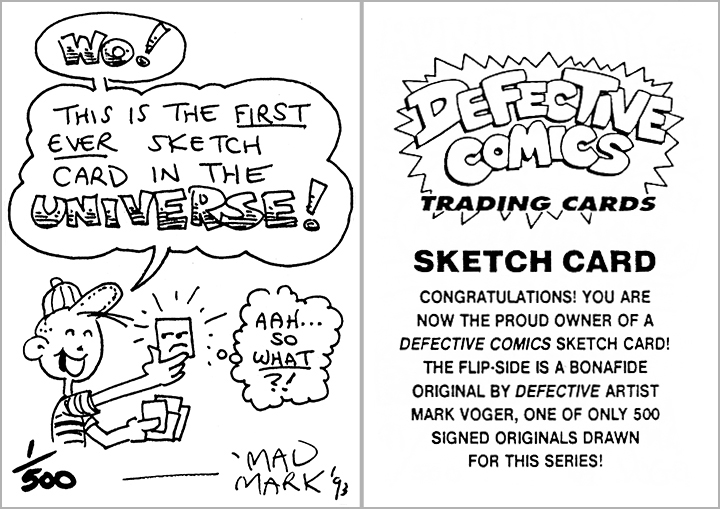
Post script
The old saying goes, “Something is only worth what someone is willing to pay for it.” But there can only be one “first” Sketch Card — not 400. And that first Sketch Card is above. No one knows where it is, or if it even still exists. But thank goodness, I Xeroxed it for posterity. (Cue flashback music.)
When I first pitched the Sketch Card concept to Active Marketing (publisher of the Hustler, Hustler II and James Dean trading card series), I knew damn well it had never been done before. I was a part of this world … I had a network of fellow eagle-eyed fans … I faithfully attended comic conventions in Manhattan and environs … visited my local comic shop every week (Comics Plus in Ocean, NJ) … wrote and drew many published comics … read the “trades” … wrote a book on the subject (“The Dark Age”) … traded information with fellow collectors and pros. I had to explain the Sketch Card concept to a trading card company, fer cryin’ out loud.
To quote the great philosophers Spandau Ballet, “I know this much is true.”
BTW: “The Simpsons” is genius! Comic Book Guy? It’s like lookin’ in the mirror.